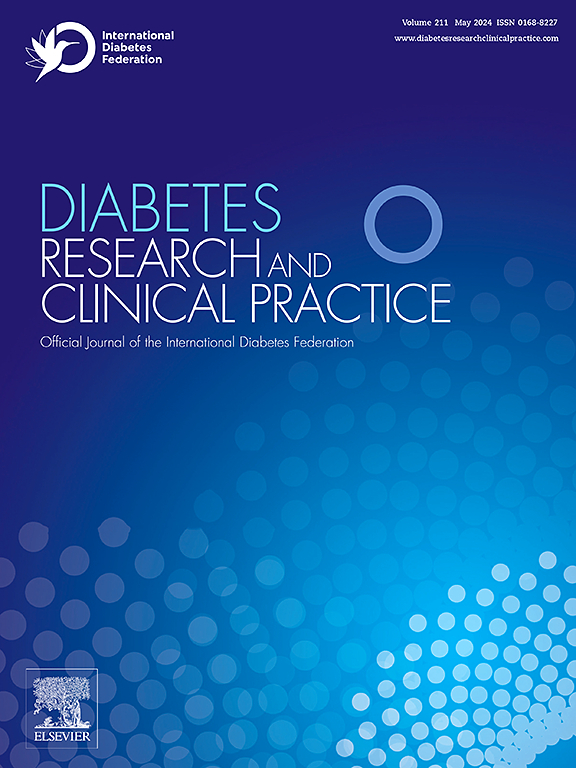Association between body roundness index and new-onset stroke risk in middle-aged and older adults with varying glucose metabolism status: A longitudinal study using CHARLS data
IF 6.1
3区 医学
Q1 ENDOCRINOLOGY & METABOLISM
引用次数: 0
Abstract
Background
The body roundness index (BRI), a novel anthropometric measure of adiposity, has not been thoroughly investigated for stroke prediction across different glucose metabolism status (GMS) in Chinese populations.
Methods
We analyzed 7,969 participants from the China Health and Retirement Longitudinal Study (2011–2020). We employed Cox regression, propensity score matching, restricted cubic splines, and sensitivity analyses to examine the BRI-stroke association. receiver operating characteristic (ROC) analysis compared BRI’s predictive performance against other anthropometric indices across GMS categories.
Result
Baseline BRI levels were positively associated with the risk of stroke for adjusting confounding variables (HR = 1.78, 95 %CI 1.30–2.43, P for trend < 0.001). Elevated BRI was consistently correlated with higher stroke risk across all Cox models, with the strongest associations observed among individuals with prediabetes (Pre-DM) and diabetes mellitus (DM) relative to those with normal glucose regulation (NGR), irrespective of whether blood glucose status was treated as a fixed variable or a longitudinal dynamic trajectory. BRI showed superior stroke prediction [area under the curve (AUC) = 0.678] versus other measures, with enhanced accuracy in Pre-DM group (AUC = 0.716) versus DM group(AUC = 0.671). Furthermore, BRI combined with biomarkers may improve stroke prediction accuracy.
Conclusion
This study identified elevated BRI independently predicts stroke risk, particularly in individuals with impaired glucose regulation.
体圆度指数与不同糖代谢状态的中老年人新发卒中风险之间的关系:一项使用CHARLS数据的纵向研究
身体圆度指数(BRI)是一种新的肥胖人体测量指标,但尚未对中国人群中不同葡萄糖代谢状态(GMS)的脑卒中预测进行深入研究。方法对中国健康与退休纵向研究(2011-2020)的7969名参与者进行分析。我们采用Cox回归、倾向评分匹配、受限三次样条和敏感性分析来检验脑卒中与脑卒中的关联。受试者工作特征(ROC)分析将BRI的预测性能与GMS类别中的其他人体测量指标进行了比较。结果调整混杂变量后,基线BRI水平与卒中风险呈正相关(HR = 1.78, 95% CI 1.30-2.43, P为趋势和lt;0.001)。在所有Cox模型中,BRI升高始终与卒中风险升高相关,与血糖调节正常(NGR)的人相比,在糖尿病前期(Pre-DM)和糖尿病(DM)患者中观察到最强的相关性,无论血糖状态是作为固定变量还是纵向动态轨迹。与其他测量方法相比,BRI显示出更好的脑卒中预测[曲线下面积(AUC) = 0.678],与DM组(AUC = 0.671)相比,预DM组(AUC = 0.716)的准确性更高。此外,BRI结合生物标志物可以提高脑卒中预测的准确性。结论:该研究发现,BRI升高可独立预测卒中风险,特别是在血糖调节受损的个体中。
本文章由计算机程序翻译,如有差异,请以英文原文为准。
求助全文
约1分钟内获得全文
求助全文
来源期刊

Diabetes research and clinical practice
医学-内分泌学与代谢
CiteScore
10.30
自引率
3.90%
发文量
862
审稿时长
32 days
期刊介绍:
Diabetes Research and Clinical Practice is an international journal for health-care providers and clinically oriented researchers that publishes high-quality original research articles and expert reviews in diabetes and related areas. The role of the journal is to provide a venue for dissemination of knowledge and discussion of topics related to diabetes clinical research and patient care. Topics of focus include translational science, genetics, immunology, nutrition, psychosocial research, epidemiology, prevention, socio-economic research, complications, new treatments, technologies and therapy.
 求助内容:
求助内容: 应助结果提醒方式:
应助结果提醒方式:


